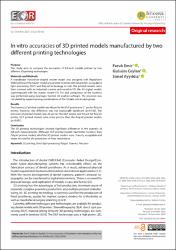| dc.contributor.author | Emir, Faruk | |
| dc.contributor.author | Ceylan, Gülsüm | |
| dc.contributor.author | Ayyıldız, Simel | |
| dc.date.accessioned | 2021-06-10T06:39:38Z | |
| dc.date.available | 2021-06-10T06:39:38Z | |
| dc.date.issued | 2021 | en_US |
| dc.identifier.citation | Emir, F., Ceylan, G. ve Ayyıldız, S. (2021). In vitro accuracies of 3D printed models manufactured by two different printing technologies. European Oral Research, 55(2), 80-85. https://dx.doi.org/10.26650/eor.20210060 | en_US |
| dc.identifier.issn | 2630-6158 | |
| dc.identifier.issn | 2651-2823 | |
| dc.identifier.uri | https://dx.doi.org/10.26650/eor.20210060 | |
| dc.identifier.uri | https://hdl.handle.net/20.500.12511/7119 | |
| dc.description.abstract | Purpose This study aims to compare the accuracies of full-arch models printed by two different 3D printing technologies. Materials and Methods A mandibular horseshoe-shaped master model was designed with RapidForm XOR2 softwareThe master model was printed 10 times with 3D printers using direct light processing (DLP) and PolyJet technology (n=20). The printed models were then scanned with an industrial scanner and saved in STL file. All digital models superimposed with the master model STL file and comparison of the trueness was performed using Geomagic Control 3D analysis software. The precision was calculated by superimposing combinations of the 10 data sets in each group. Results The trueness of printed models was 46 pm for the DLP printer and 51 pm for PolyJet printer; however, this difference was not statistically significant (p=0.155). The precision of printed models was 43 pm for the DLP printer and 54 pm for PolyJet printer. DLP printed models were more precise than the PolyJet printed models (p<0.001). Conclusion The 3D printing technologies showed significant differences in the trueness of full-arch measurements. Although DLP printed models had better trueness than PolyJet printed models, all of the 3D printed models were clinically acceptable and might be used for the production of fixed restorations. | en_US |
| dc.language.iso | eng | en_US |
| dc.publisher | Istanbul University Press | en_US |
| dc.rights | info:eu-repo/semantics/openAccess | en_US |
| dc.rights | Attribution-NonCommercial 4.0 International | * |
| dc.rights.uri | https://creativecommons.org/licenses/by-nc/4.0/ | * |
| dc.subject | 3D Printing | en_US |
| dc.subject | Direct Light Processing | en_US |
| dc.subject | Polyjet | en_US |
| dc.subject | Trueness | en_US |
| dc.subject | Precision | en_US |
| dc.title | In vitro accuracies of 3D printed models manufactured by two different printing technologies | en_US |
| dc.type | article | en_US |
| dc.relation.ispartof | European Oral Research | en_US |
| dc.department | İstanbul Medipol Üniversitesi, Diş Hekimliği Fakültesi, Protetik Diş Tedavisi Ana Bilim Dalı | en_US |
| dc.authorid | 0000-0003-0768-8779 | en_US |
| dc.identifier.volume | 55 | en_US |
| dc.identifier.issue | 2 | en_US |
| dc.identifier.startpage | 80 | en_US |
| dc.identifier.endpage | 85 | en_US |
| dc.relation.publicationcategory | Makale - Uluslararası Hakemli Dergi - Kurum Öğretim Elemanı | en_US |
| dc.identifier.doi | 10.26650/eor.20210060 | en_US |



















